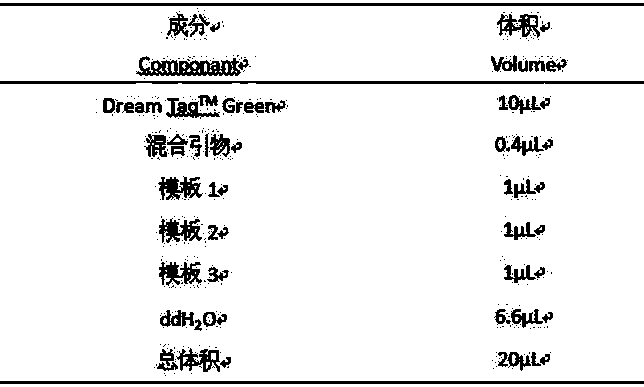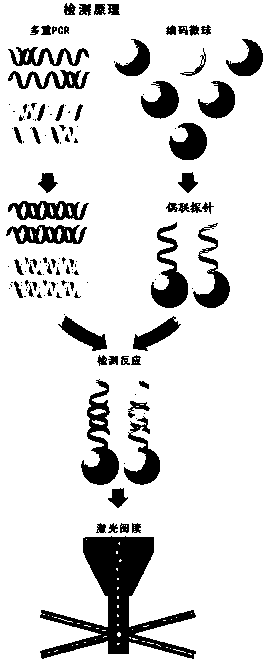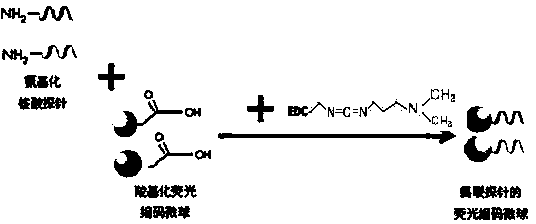Triple detection method of arbovirus liquid chips
A technology of arboviruses and arboviruses, applied in the direction of microorganism-based methods, resistance to vector-borne diseases, biochemical equipment and methods, etc., can solve problems such as difficult distinction and identification, simplify operation steps and reduce workload , The effect of improving the sensitivity
- Summary
- Abstract
- Description
- Claims
- Application Information
AI Technical Summary
Problems solved by technology
Method used
Image
Examples
Embodiment 1
[0071] Embodiment 1: PCR multiple amplification
[0072] 1) Design of primers and probes
[0073] Primer 5.0 software was used to design primers and probes, both of which were synthesized by Songbao Bioengineering (Dalian) Co., Ltd., and the sequences and primer-related information are shown in Table 1;
[0074] Table 1 Liquid-phase chip detection genes and related primers and probe sequences
[0075]
[0076] In addition, we also used the online sequence alignment tool http: / / multalin.toulouse.inra.fr / multalin / multalin.html to perform multiple sequence alignments on the three probes, and the results showed that the sequence consistency of the three probes was poor , indicating that the probability of the three probes forming a cross-reaction is very small, and the results are as follows figure 2 shown;
[0077] Since the simultaneous amplification of multiple primers is involved in the multiplex PCR amplification system, the performance requirements of the primers f...
Embodiment 2
[0091] Embodiment 2: Preparation of microsphere mixture
[0092] 1) Nucleic acid probes are coupled to fluorescently encoded microspheres
[0093] The principle of the coupling reaction between carboxylated fluorescently encoded microspheres and aminated probes is as follows: image 3 shown. The three nucleic acid probes designed in this research are coupled with different numbers of fluorescently encoded microspheres, and the numbers of nucleic acid probes and corresponding fluorescently encoded microspheres are shown in the table below;
[0094] Table 5 Nucleic acid probes and microsphere numbers
[0095]
[0096] The coupling method of nucleic acid probes and fluorescently encoded microspheres is operated according to the instruction manual of the nucleic acid liquid phase chip coupling kit provided by Shenzhen Borui Xianghui Biotechnology Co., Ltd. The specific method is as follows:
[0097] 2) Experiment preparation:
[0098] Equilibrate all reagents to room tem...
Embodiment 3
[0128] Example 3: Establishment of arbovirus liquid chip triple detection method, hybridization of PCR product and microsphere mixed solution, liquid chip detection
[0129] In the hybridization reaction, four gradients are set for the loading amount of PCR products, which are 1 μL / reaction, 3 μL / reaction, 5 μL / reaction, and 7 μL / reaction, and the optimal loading amount is determined according to the test results;
[0130] 1) Experimental steps
[0131] Shake the resuspended microsphere mixture at full speed for about 3 minutes;
[0132] For each sample well and background well, add 10 μL of microsphere mixture, and then add 33 μL of nucleic acid detection buffer 1 (1.5×TMAC);
[0133] For each background well, add 1μL / 3μL / 5μL / 7μL PCR blank product;
[0134] For each sample well, add 1μL / 3μL / 5μL / 7μL of PCR product;
[0135] Make up the volume to 50 μL with Nucleic Acid Detection Buffer 2 (1.0×TMAC);
[0136] Thoroughly mix the components in the reaction well;
[0137...
PUM
| Property | Measurement | Unit |
|---|---|---|
| Sensitivity | aaaaa | aaaaa |
| Sensitivity | aaaaa | aaaaa |
| Sensitivity | aaaaa | aaaaa |
Abstract
Description
Claims
Application Information
 Login to View More
Login to View More - R&D
- Intellectual Property
- Life Sciences
- Materials
- Tech Scout
- Unparalleled Data Quality
- Higher Quality Content
- 60% Fewer Hallucinations
Browse by: Latest US Patents, China's latest patents, Technical Efficacy Thesaurus, Application Domain, Technology Topic, Popular Technical Reports.
© 2025 PatSnap. All rights reserved.Legal|Privacy policy|Modern Slavery Act Transparency Statement|Sitemap|About US| Contact US: help@patsnap.com



